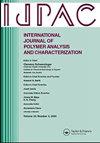Fast and energy efficient crosslinking of PVA to make water resistant coating using glutaraldehyde
IF 1.6
4区 工程技术
Q4 POLYMER SCIENCE
International Journal of Polymer Analysis and Characterization
Pub Date : 2025-10-03
DOI:10.1080/1023666X.2025.2504562
引用次数: 0
Abstract
Glutaraldehyde has recently drawn attention as a crosslinking agent for PVA due to its ability to facilitate reactions under ambient conditions. The study focused on comparing the effects of glutaraldehyde, formaldehyde, and glyoxal as crosslinking agents for PVA under similar conditions, using different aldehyde-to-PVA ratios (0.2, 0.4, 0.6, 0.8, and 1.0). The crosslinking reaction was conducted at 50 °C for a duration of 5 min, to assess the efficiency of crosslinking agents at milder conditions. Initial evaluations focused on determining the water swelling degree, the degree of crosslinking, and moisture uptake of the prepared films under humid conditions. Results demonstrated a high degree of crosslinking: with glutaraldehyde at GA/PVA ratios of 0.6 and 0.8, crosslinking reached 99%. Formaldehyde achieved a crosslinking degree of 97% at an FA/PVA ratio of 0.8, while glyoxal reached 90% at a ratio of 0.2. Among the aldehydes tested, glutaraldehyde exhibited the highest crosslinking efficiency under similar conditions, making it the preferred crosslinker for further characterization studies. FTIR, TGA, and XRD spectra confirmed successful crosslinking between GA and PVA, evidenced by acetal bond formation and changes in the diffraction patterns correlating with increased amorphous character in the PVA films.
戊二醛用于聚乙烯醇快速高效交联制备防水涂料
戊二醛作为聚乙烯醇的交联剂,由于其在环境条件下促进反应的能力,最近引起了人们的关注。本研究的重点是比较戊二醛、甲醛和乙二醛作为交联剂在相似条件下,使用不同的醛与PVA的比例(0.2、0.4、0.6、0.8和1.0)对PVA的影响。交联反应在50℃下进行,持续时间为5分钟,以评估交联剂在温和条件下的效率。初步评价的重点是确定在潮湿条件下制备的薄膜的水膨胀度、交联度和吸湿性。结果表明,在GA/PVA比为0.6和0.8时,戊二醛的交联度达到99%。当FA/PVA比为0.8时,甲醛的交联度为97%,当FA/PVA比为0.2时,乙二醛的交联度为90%。在测试的醛类中,戊二醛在相似的条件下表现出最高的交联效率,使其成为进一步表征研究的首选交联剂。FTIR, TGA和XRD光谱证实了GA和PVA之间成功的交联,证明了缩醛键的形成和PVA薄膜中无定形特性增加相关的衍射图的变化。
本文章由计算机程序翻译,如有差异,请以英文原文为准。
求助全文
约1分钟内获得全文
求助全文
来源期刊
CiteScore
3.50
自引率
5.30%
发文量
37
审稿时长
1.6 months
期刊介绍:
The scope of the journal is to publish original contributions and reviews on studies, methodologies, instrumentation, and applications involving the analysis and characterization of polymers and polymeric-based materials, including synthetic polymers, blends, composites, fibers, coatings, supramolecular structures, polysaccharides, and biopolymers. The Journal will accept papers and review articles on the following topics and research areas involving fundamental and applied studies of polymer analysis and characterization:
Characterization and analysis of new and existing polymers and polymeric-based materials.
Design and evaluation of analytical instrumentation and physical testing equipment.
Determination of molecular weight, size, conformation, branching, cross-linking, chemical structure, and sequence distribution.
Using separation, spectroscopic, and scattering techniques.
Surface characterization of polymeric materials.
Measurement of solution and bulk properties and behavior of polymers.
Studies involving structure-property-processing relationships, and polymer aging.
Analysis of oligomeric materials.
Analysis of polymer additives and decomposition products.

 求助内容:
求助内容: 应助结果提醒方式:
应助结果提醒方式:


